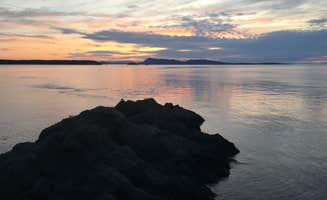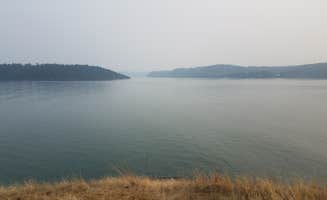Dispersed camping near Eastsound, Washington presents unique challenges related to island geography and water access. The San Juan Islands archipelago consists of 172 named islands and reefs, with Orcas Island (where Eastsound is located) being the largest at 57 square miles. Winter temperatures typically range from 40-50°F, while summer averages 70-75°F with relatively low rainfall compared to mainland Washington.
What to do
Wildlife observation at dawn and dusk: Hope Island Marine State Park offers exceptional opportunities for spotting marine mammals. According to camper Jess G., "There were some sea lions swimming around in the area but never actually approached the land. Awesome time!" The island features a trail that circles its perimeter, providing multiple viewing points.
Kayaking to secluded campsites: Point Doughty requires careful planning for water landings. One camper notes, "During low tide it is very rocky and tough on fiberglass kayaks, but there's a small path that can launch one or two kayaks at a time." Water access timing is crucial for safe arrivals and departures.
Trail exploration on small islands: Several dispersed camping locations offer short hiking trails with minimal elevation gain. At Hope Island Marine State Park, Jess G. shares, "Beautiful views with a trail that circles the island. Very romantic setting!" Most island trails are under 2 miles total, making them suitable for casual walks.
What campers like
Complete solitude on certain islands: Hope Island camping provides remarkable privacy during weekdays and shoulder seasons. Raphaela H. recounts, "I was worried, with only four camping spots, that we wouldn't get one, but we ended up being the only people on the island."
Marine wildlife encounters: The waters around these dispersed sites host diverse marine life. At Pine Lake Campground, visitors regularly report spotting river otters, bald eagles, and various waterfowl along the shoreline.
Primitive camping with basic amenities: Most dispersed sites feature minimal facilities. At Point Doughty, Pat M. reports the area has "Only 3 non-reservable sites with tables and fire pits on DNR land," providing just enough infrastructure for comfort without overcrowding.
What you should know
Access constraints are significant: Most dispersed camping requires watercraft. Jess G. advises regarding Hope Island, "We kayaked to the island, the waters were pretty rough so I would recommend for anyone planning to stay here to look into the waters, tide and wind report the day of."
Limited facilities and supplies: Nearly all dispersed sites lack running water. Toilet facilities range from none to basic vault toilets. Pat M. notes about Walker Valley ORV Recreation Area, "No toilet facilities whatsoever, so campers need to bring portable options and pack out all waste."
Steep terrain at water access points: Many island campsites sit atop bluffs. One camper describes Point Doughty: "The path up to the sites from the beach is very steep and slippery on the dirt but there is a rope to help. Looks like they're trying to create a stairway in the future."
Tips for camping with families
Pack ultra-light for boat-accessible sites: When kayaking to dispersed sites, minimize gear. Pat M. cautions about Point Doughty, "Not recommended if you need to haul myriad items up to the campground," suggesting families bring only essentials.
Consider shared trail spaces: Some campsites experience day hiker traffic. Duane and Janey D. warn about Pine Lake Campground, "Cute sites, but you will be interrupted 500 times a day with walkers who use the trail and want to go straight through your site."
Prepare for wildlife encounters: Islands often have resident wildlife. When camping at Hope Island, Jess G. reports, "there were raccoons on the island with us but other than that we had the place to ourselves," suggesting proper food storage is essential.
Tips from RVers
Limited vehicle camping options: True dispersed RV camping near Eastsound is nearly non-existent. The few accessible options require advance permits during peak season (June-September) and typically have no hookups available.
Consider mainland locations for larger vehicles: For RV campers, mainland locations within 1-2 hours driving distance provide more suitable options than the immediate Eastsound area, which primarily offers boat-in and hike-in dispersed camping.



